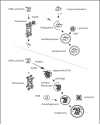Cross-presentation of tumor associated antigens through tumor-derived autophagosomes
- PMID: 19333005
- PMCID: PMC3128909
- DOI: 10.4161/auto.5.4.8366
Cross-presentation of tumor associated antigens through tumor-derived autophagosomes
Abstract
Cross-presentation of exogenous antigens by host professional antigen-presenting cells (APCs) plays a pivotal role in the initiation and development of T-cell immune responses to tumor-associated antigens, including self or mutated self-antigens derived from tumor cells, and foreign antigens derived from infectious agents. Cross-presentation requires multiple steps that involve the antigens' synthesis and compartmentalization in donor cells, packaging and delivery, and processing and presentation by MHC class I molecules on professional APCs. The intricate pathways that lead to protein degradation and the formation of MHC I-peptide complexes inside the APC are well documented for both soluble and particulate antigens. However, much less is known about how cross-presentation is regulated by the protein degradation pathways in antigen-donor cells (ADCs), including autophagy-mediated lysosomal proteolysis and proteasomal degradation. The exact nature or form of the antigens derived from donor cells at the time of delivery to the APC for cross-presentation is very controversial.
Figures

Similar articles
-
Cross-presentation of synthetic long peptides by human dendritic cells: a process dependent on ERAD component p97/VCP but Not sec61 and/or Derlin-1.PLoS One. 2014 Feb 27;9(2):e89897. doi: 10.1371/journal.pone.0089897. eCollection 2014. PLoS One. 2014. PMID: 24587108 Free PMC article.
-
Impact of the TAP-like transporter in antigen presentation and phagosome maturation.Mol Immunol. 2019 Sep;113:75-86. doi: 10.1016/j.molimm.2018.06.268. Epub 2018 Jun 23. Mol Immunol. 2019. PMID: 29941219
-
Autophagy and proteasome interconnect to coordinate cross-presentation through MHC class I pathway in B cells.Immunol Cell Biol. 2016 Nov;94(10):964-974. doi: 10.1038/icb.2016.59. Epub 2016 Jun 14. Immunol Cell Biol. 2016. PMID: 27297581
-
Alternative pathways for MHC class I presentation: a new function for autophagy.Cell Mol Life Sci. 2011 May;68(9):1533-41. doi: 10.1007/s00018-011-0660-3. Epub 2011 Mar 10. Cell Mol Life Sci. 2011. PMID: 21390546 Free PMC article. Review.
-
Autophagy and MHC-restricted antigen presentation.Mol Immunol. 2018 Jul;99:163-170. doi: 10.1016/j.molimm.2018.05.009. Epub 2018 May 19. Mol Immunol. 2018. PMID: 29787980 Review.
Cited by
-
Therapeutic Antitumor Efficacy of Cancer Stem Cell-Derived DRibble Vaccine on Colorectal Carcinoma.Int J Med Sci. 2021 Jul 23;18(14):3249-3260. doi: 10.7150/ijms.61510. eCollection 2021. Int J Med Sci. 2021. PMID: 34400894 Free PMC article.
-
Autophagy-mediated dendritic cell activation is essential for innate cytokine production and APC function with respiratory syncytial virus responses.J Immunol. 2011 Oct 15;187(8):3953-61. doi: 10.4049/jimmunol.1100524. Epub 2011 Sep 12. J Immunol. 2011. PMID: 21911604 Free PMC article.
-
Immunotherapeutic Challenges for Pediatric Cancers.Mol Ther Oncolytics. 2019 Aug 28;15:38-48. doi: 10.1016/j.omto.2019.08.005. eCollection 2019 Dec 20. Mol Ther Oncolytics. 2019. PMID: 31650024 Free PMC article. Review.
-
Principles and current strategies for targeting autophagy for cancer treatment.Clin Cancer Res. 2011 Feb 15;17(4):654-66. doi: 10.1158/1078-0432.CCR-10-2634. Clin Cancer Res. 2011. PMID: 21325294 Free PMC article. Review.
-
Therapeutic antitumor efficacy of tumor-derived autophagosome (DRibble) vaccine on head and neck cancer.Int J Nanomedicine. 2015 Mar 10;10:1921-30. doi: 10.2147/IJN.S74204. eCollection 2015. Int J Nanomedicine. 2015. PMID: 25792826 Free PMC article.
Publication types
MeSH terms
Substances
Grants and funding
LinkOut - more resources
Full Text Sources
Other Literature Sources
Research Materials
Miscellaneous
